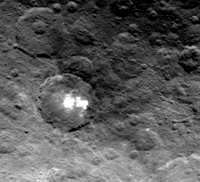 |
| Above: An animation composed of images taken by dawn, showing Cere's spinning undernaeth the probe. notice how many tensy little bright spots now join the big one. Courtesy of JPL/NASA |
Nature isn't giving up here secrets that easily. We can now see the structure of the bright spots, but we're no closer to understanding what weird kind of alien geology has produced them. In fact the mystery deepens: We can now see the bright spot is actually a cluster of scattered bright pots - and there are more, smaller, bright patches scattered across the surface!
Above: The biggest bright spots, shown just as the Sun is rising on them and at around midday. We're beginning to see structure here, but still have no idea what it means. Courtesy of JPL/NASA/Unmannedspaceflight.com
The bright spots aren't the whole of the strange story though. Ceres has a number of enigmatic mountain like features. The one in the animation below definitely looks like it might be volcanic in origin, which would make it a marker of cryovoclanic (volcanoes that erupt melted ice instead of rock) activity - which in turn could tell us how long ago Ceres definitely had liquid water beneath its surface, and what the chances are that any remains today
 |
| Above: A close up on a possible extinct/dormant cryovolcano. |
- Melting ice rose through the crust (i.e. 'cryovolcanism') via fractures caused by impacts or tectonic forces.
- Salty deposits were left behind along the fracturess as intrusive deposits, and salt water may have erupted onto the surface.
- Subsequent impacts and other erosion have cause exposed salts to fade over time.
- In a few cases an placed impact or landslide could expose some of the preserved deposits.
I've read people of a geological background proposing very similar explanations in a few places. Dr Tom McCord, a co-investigator on the Dawn mission, has gone on record at a Seattle astronomy event as saying he thinks these bright spots could be salt deposits. There's more on what he thinks Dawn is seeing here.

No comments:
Post a Comment